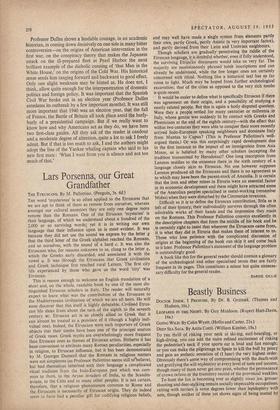Beastly Business
GOING WILD. By Colin Wyatt. (Hollis and Carter, 21s.) DEEP SEA SAGA. By Anita Conti. (William Kimber, 18s.) To THE thrill of risking your neck at ski-ing, surf-boardipg, or high-diving, you can add the more refined excitement of risking the pedestrian's neck if your sports car is loud and fast enough; or you can make the pilgrimage to Spain to kill the bull by proxy and gain an wsthetic sensation of (I hear) the very highest order. Obviously there's some way of compromising with the death-wish and gratifying the will-todestroy at every level of taste and income, though many of them never get into print, whether the permanence of crown octavo or the transitory record of the provincial weeklies.
To hunt the fox is becoming ever so slightly vieux jeu, grouse- shooting and deer-stalking remain socially impeccable occupations, ratting with terriers is some degrees lower than lepidoptcry with nets, though neither of these yet shows signs of being ousted by
the rapidly expanding teenage sport of kitten-strangling. Perhaps we should interpret the appearance of so many books recording adventures with rod, gun and net (backed by a secondary armament of camera and typewriter) as a cheering sign of the return to pre-war normality? Not all these authors concern them- selves solely with destruction, however, and in one case the pursuit and capture process is for the acquisition of food.
Dr. Grzimek directs the Frankfurt Zoo and describes a trip to the Ivory Coast, when he searched for specimens to restock his own collection. Mostly the story tells of his trips around the region of the Ivory Coast, French Guinea and the Nimbu Mountain Animal Preserve; he is brave, intelligent, sympathetic towards animals and coloured men. He discourses on such oddities as weaver-birds, the potto and the termite very fascinatingly; he shoots only with a camera, and a hypodermic needle whenever his son or a chimpanzee gets poisoned or restless. A lot of his tale shows him rather unimaginative; he tells jokes against himself, and finally sets off for the coast and home with an assortment of monkeys. His chief bag, a fine male chimpanzee, dies as soon as he reaches Frankfurt. I don't see much logic or perspicacity in his discussions in defence of zoos, animal preservation, or animal psychology.
Mr. Muldoon is almost the exact opposite; as an agricultural officer in Nyasaland it was his duty to slaughter the animals he loved, and this is a lengthy saga about how and where, and with whose help, he killed efficiently various baboons, crocodiles, lions, leopards, and buffaloes. He manages to do it in a fairly tight- lipped way (if we accept the blurb about the hunter, loving all that he destroys); but the story is packed with interest if you enjoy the detail of tracking down, relentlessly pursuing, pitting your wits against the animals'.
Mr. Wyatt operates on a larger scale, for he has gone in and out of, and round about, almost everywhere except Latin America in pursuit of several thousands of kinds of butterflies. Having met his first animal-characters in the Beatrix Potter books, he was taken out and about to meet the 'real thing' at the age of six, already equipped with nets and setting-boards, and instructed in the, ways of catching, setting and identifying butterflies. He is a fascinating talker, and as he puts in.all the detail about travelling, camping; the scenery, and the flora as well as the fauna, he has packed his book with something for everybody—that is, every- body who sees that there is some sort of point in appreciating Nature by stuffing it into collectors' cabinets. If you already know anything about butterflies, Mr. Wyatt can tell you even more about almost every kind. He is particularly endearing when he relates how many times he has nearly broken his neck climbing rocks and cliffs in pursuit of rare specimens. He always caught one, of course.
Mlle. Conti has an odd job; she is a scientific worker for the French Deep Sea Fisheries Service, and has made many trips on trawlers and other vessels to study fish migration, and to advise on fishery problems generally. On this occasion she joined the sixty-man crew of a splendidly modern diesel-engined trawler engaged on a five-months' trip to the Labrador and Greenland banks in pursuit of, cod. Salt cod is still important in the dietary of many European countries, and the Bois-Rose, equipped with radar, deep-sounding apparatus (and really professional cooks!) cruised up and down and around and across the region off Eastern Canada until she had got over a thousand tons salted down in her storerooms. Mlle. Conti has a wonderful tale to tell, though it is marred here and there by her—or her translator's—uncertainty about technical terms; her attempts don't really make clear to the uninitiated just how a trawl is set and shot, or how it is drawn and emptied. But she admires the sheer, slugging hard work that goes on night and day; builds up exciting accounts of the search- ing for good fishing ground, of the intimate and peculiar pattern of living that goes with this way of working. She draws us into the community of the Bois-Rosé for a while and paints a faithful picture of a job that very few outsiders know anything about; and it is perfectly held together by her own quite magnificent photographs which show the ordered chaos, the concentration of work, the harsh conditions—almost, even, persuade you of the
FINANCE AND INVESTMENT
By NICHOLAS DAVENPORT




































 Previous page
Previous page